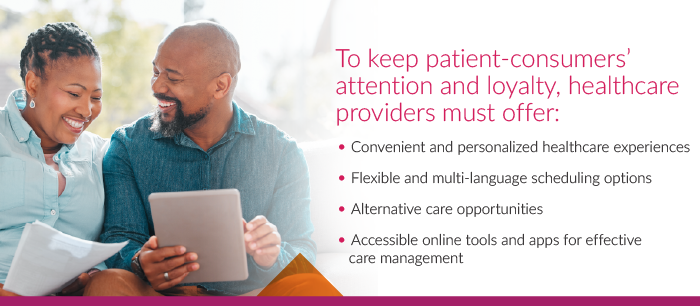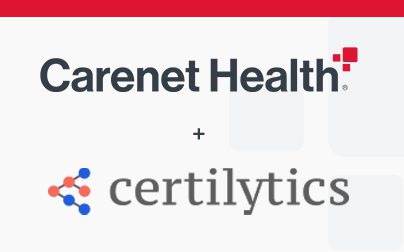
This past year showed us healthcare consumers have more care options than ever before. However, we have learned not all options are the most convenient, appropriate, or cost-effective for every individual. Additionally, hospitals and health systems are dealing with overcrowding and high-volume patient loads following spikes of COVID-19, the flu, and RSV. With a close pulse on industry trends and supporting one-third of Americans through their health plan, provider, or pharmacy, Carenet Health experts identified areas across the system that will improve the business of healthcare by optimizing revenues, improving care access, and streamlining the patient and member experience. Our leaders share how to route healthcare consumers to the best-fit care option, utilize technology in an empathetic and meaningful way, and simultaneously strengthen revenue and deliver better health outcomes.
Staffing shortages and inefficiencies, spikes in infectious disease, labor strikes, natural disasters, and the aging U.S. population will perpetuate the healthcare workforce crisis through 2024 and beyond.
Here are the top predictions for healthcare trends to better prepare payers and providers in 2024:
Creativity and outsourcing are the solutions to the healthcare labor crisis
Staffing shortages and inefficiencies, spikes in infectious disease, labor strikes, natural disasters, and the aging U.S. population will perpetuate the healthcare workforce crisis through 2024 and beyond. When discussing burnout and shortages in healthcare, the focus is often too narrow. Nurses and physicians are not the only ones at risk. The entire hospital staff — administrative and other jobs included — need their leaders to adopt innovative technology and adjust workflows and workloads to maximize their job efficiency and satisfaction. The crisis requires payers and providers to implement innovative staffing solutions and outsource healthcare call center needs to a business process outsourcing (BPO) organization to mitigate the labor crisis’s impact on patient care, ease the strain on the workforce, and save time and money.
Adopting recruitment or retention strategies can ease the cost and pessimism associated with labor shortages. A report from Kaufman Hall found that health systems that implemented at least one recruitment or retention strategy such as raising salaries (98%), introducing signing bonuses (84%), and increasing opportunities for remote, or hybrid work schedules (76%) reduced labor costs. Scaling back the use of contract labor, leveraging automation, changing care delivery models, and outsourcing responsibilities were also associated with reduced labor costs.

According to Bain’s 2023 Healthcare Provider IT Report, 80% of healthcare executives surveyed reported a sizable increase in IT and software investment to confront their most pressing challenges, including burnout. This type of strategic investment has the power to change healthcare labor and consumer experiences in 2024.
Nursing staff turnover, accelerated by unaddressed burnout, poses a serious threat to provider organization revenues. An NSI National Health Care Retention & RN Staffing Report found that the average cost of turnover for a bedside registered nurse is $46,100, resulting in the average hospital losing between $5.2 million and $9 million. Hybrid nursing (or “co-caring”) models – which entail staffing structures that incorporate remote-first clinicians to supplement in-clinic staff – is one creative solution that will grow in 2024 to address this challenge. To reduce the burden on nurses and support medical teams, hybrid nursing uses technology to help virtual nurses assist bedside teams through a bi-directional audio and video platform. These nurses can help monitor patients and handle processes related to admissions, discharge preparation, the creation of checklists prior to a procedure, and more. While there is little interest in a fully remote care experience among patients, 56% of respondents to Carenet’s U.S. Consumer Trends in Patient Engagement Survey said they are open to telehealth visits for some providers, and a growing number of members seek advice from their health plan through nurse advice lines, further diverting care from in-person clinics to remote care alternatives.
56% of respondents to Carenet’s U.S. Consumer Trends in Patient Engagement Survey said they are open to telehealth visits for some providers, and a growing number of members seek advice from their health plan through nurse advice lines.
In an interview on adopting solutions that benefit both patients and clinicians at the 2023 HLTH conference, Carenet’s Patches Seely, MBA, BSN, RN, and EVP of Clinical Solutions, told Swaay.Health editor and founder John Lynn, “We tend to focus on the physician and the nurse – both are critically important roles – but every one of us can speak to the myriad of clinicians that make up part of our care teams. We have to increase our inclusivity of which clinicians we choose because we’re going to have to get really creative with the members of a care team. Nursing is in shortage. Physicians are struggling with burnout and challenges, so we really must get creative about the human capital and how we’re engaging talent around an individual.”
“We tend to focus on the physician and the nurse – both are critically important roles – but every one of us can speak to the myriad of clinicians that make up part of our care teams. We have to increase our inclusivity of which clinicians we choose because we’re going to have to get really creative with the members of a care team.” – Patches Seely, MBA, BSN, RN, and EVP of Clinical Solutions
This new reality of care delivery and workforce capacity in 2024 requires thoughtful use of all channels of care and communication.
Use AI wisely to elevate care and empathy
With the emergence of the latest technologies and software, including virtual reality and generative AI such as ChatGPT, organizations are sprinting to leverage these new tools in fear of losing relevance in the marketplace. There is an imminent need to use AI to streamline processes and administrative workload to alleviate the labor crisis. In healthcare, the arrival of AI will accelerate developments in interactive and customized patient experiences, streamlined administrative tasks and provider workflows, and improved access to healthcare.
The use of AI to assist in documenting patient information will continue to grow in 2024. The industry can expect improved natural language processing (NLP) models that streamline the documentation process, improve accuracy, and reduce administrative burden on clinicians so they can spend more of their time caring for patients. Furthermore, AI’s role in aiding clinicians in the interpretation of medical scans will advance with the refinement of deep learning algorithms that can identify subtle abnormalities in images to provide more accurate diagnoses and enhance patient care. These technologies will not only excel at singular tasks but will also evolve to become increasingly versatile and capable of supporting complex decision-making.
However, there is still work to be done. As healthcare costs continue to rise and revenue margins tighten, providers and payers will face increasing pressures to develop cost-effective strategies and invest in leading-edge technologies such as AI and machine learning to streamline processes and cut costs. Some AI tools aren’t yet equipped to source from up-to-date and relevant materials, require human editors to double-check the results, and still need to be optimized to recognize and appropriately address healthcare consumers’ emotions. As these are still emerging technologies, it is imperative to understand potential risks and safeguard compliance, including HIPAA, to ensure unauthorized use of patient data does not occur. Christopher Rogers, Chief Operating Officer at Carenet, told MedCity News, “The security of AI-generated data is also a concern as technologies like ChatGPT require vast amounts of data to inform and drive their language processing capabilities. The effort to safeguard data breaches involving personal information and electronic health records (EHRs) will require vigilance.” He continued to explain the risk of using generative AI to self-medicate, which can result in a misdiagnosis. “The sweet spot for those seeking healthcare-related information is to view AI as a helpful tool to use in combination with seeking care from medical professionals. In some ways, AI-generated information can be considered akin to obtaining a second or even third opinion regarding one’s health – it makes up part of what needs to be known, but it’s not the entire story.”
Ultimately, AI should be a tool that enables more empathetic, human experiences. To digitize healthcare and lean on emerging technologies, it’s imperative to identify the opportunity within the relationship between machine and human to provide the compassionate touch in care. In an op-ed in MedCity News, Patches Seely highlighted AI’s ultimate potential for the future: “There is an inherent opportunity that emerges for AI to be used to help physicians provide better, compassionate, and empathetic care. Whether we use AI in training or to help free up time and space for healthcare workers to provide better care, we need to continue exploring effective AI use across the care continuum to help every member— patient and provider included.”
Payers and providers must get competitive with consumerism or lose financially
Increased healthcare competition and access to information, the rise of virtual care, and the demand for more personalized healthcare experiences are driving consumerism in healthcare more than ever. Those that choose not to provide the essential amenities that healthcare consumers expect—such as online self-scheduling and appointment reminders— will not survive the increase in industry competition. As Christopher Rogers told Forbes, “As competition from major retailers and big tech companies continues to infiltrate the [healthcare] marketplace, online patient scheduling options are now a must-have feature for hospitals and health systems. The health systems that do not offer online patient scheduling will not only be left behind but will be left out, especially as patients are becoming more reliant on digital sources when selecting their providers.”

The era of seeing the same provider for decades is over, as patients value convenience over loyalty to a single provider. Offering convenience and self-scheduling is critical to retaining patients—especially patients of the younger generation. In Carenet’s U.S. Consumer Survey, 95% of respondents aged 55 and over reported they had stayed with the same practice or primary care physician for routine care. Among 18- to 34-year-olds, that number dropped to 82%, showing that younger adults are less loyal to their providers and more likely to consider alternatives. Patients seek convenience and do not want to wait to obtain care; if care isn’t easily available through one provider, they will find it elsewhere.

Convenient self-scheduling options are only one piece of the puzzle. To stay relevant and stand out, healthcare providers must build trust with patient-consumers and provide accessible and personalized healthcare experiences. This draws in new patients and helps existing patients feel cared for (i.e. an empathetic provider-patient interaction). “An excellent healthcare provider is someone who is invested in you and your health and wellbeing,” said Carenet CEO John Erwin in Authority Magazine.
Building a broader web of healthcare support around patients tailored to the individual’s needs is paramount for both the patient experience and hospitals’ and health systems’ revenues. Not only does this customized approach increase consumer loyalty and ensure faster, better care for patients, it helps steer patients toward in-network care that keeps revenue within the system. As of 2023, 55% to 65% of referrals were being sent to out-of-network providers, adding up to nearly $1 million per physician. With 10% to 30% of a hospital’s revenue on the line due to patient leakage, embracing consumerization is no longer negotiable.
Additionally, with the transition to value-based care, engaging patients and tailoring care is critical to promoting better health outcomes to achieve maximum reimbursement. Value-based care adoption has grown substantially over the past decade, and growth in this area may be on track to reach $1 trillion in enterprise value for payers, providers, and investors. This transition from fee-for-service to value-based care further incentivizes payers and providers to engage patients and members and direct them to timely, preventative, and routine care. In order to do so, payers and providers must streamline and optimize the consumer experience.
Another incentive to embrace consumerism in healthcare is the Centers for Medicare & Medicaid Services’ (CMS) Star Rating system. This system has updated its rankings and now rates health plans on a myriad of variables including member experience, beneficiary health, customer service performance, member complaints, and member chronic condition management.

Health plans must leverage technology and multi-channel approaches to engage members and improve their experience. According to Carenet’s 2023 Healthcare Consumer Insights Report: Understanding the Health Insurance Member Experience, the majority of surveyed members said using technology to manage their health is important. The monetary benefits for health plans and providers are self-evident as well. One large Medicare Advantage plan utilizing a member engagement approach increased its revenue by $700 million. Payers and their provider counterparts are leaving a goldmine of revenue, reimbursement, and positive patient/member sentiment on the table if they don’t embrace technology-enabled, convenient, and meaningful care.
Increased need to unlock new levels of access, education, and health equity
Although the use of technology has a myriad of benefits, payers and providers still need to educate consumers on what to look for when booking appointments, finding specialists, or negotiating medical bills to ensure optimal patient-member engagement and retention. While technology has brought care into the consumer’s home and tackled accessibility, affordability is a key deciding factor for most consumers when choosing to delay or pursue care. As Vikie Spulak, Executive Vice President, Strategic Accounts at Carenet explains in Healthcare IT Today, “It is imperative to focus on diverse populations, including those on Medicaid receiving necessary treatment, and especially those that lack access to the internet or new technologies.”
“It is imperative to focus on diverse populations, including those on Medicaid receiving necessary treatment, and especially those that lack access to the internet or new technologies.” – Vikie Spulak, Executive Vice President, Strategic Accounts at Carenet
For instance, language barriers have a profound limiting factor on positive health outcomes. They can lead to miscommunication between patients and medical professionals, reduce patient satisfaction, and have adverse effects on healthcare quality and patient safety. Skip Hanson, Executive Vice President of Service Delivery, explained to Health Data Management, “Embracing technology and innovation can further enhance language access, making healthcare more inclusive and equitable. By leveraging multilingual telehealth, engagement, and clinical support and advocacy solutions, organizations can drive patient access and adherence, empowering healthcare consumers to seek preventative care and take more control of their health.”
Additionally, payers and providers must anticipate consumer preferences and behavior by letting consumer data lead the way. Nontraditional, user-friendly entrants like Amazon (i.e. primary care services for $9 per month) are already experts at leveraging consumer data for an economically, racially, and behaviorally diverse American population. They know how to anticipate spikes in healthcare demand, leverage digital front doors that aggregate consumers’ health history in one place, and personalize their offerings to consumer preferences and needs.
Expanding accessibility translates to patient and member revenue potential – something big tech and retail are keenly aware of and are ready to capitalize on, especially if traditional healthcare institutions are too slow on the draw.
“Providers that can excel at understanding today’s healthcare consumers, solving their pain points and offering choice, convenience, and control will be more competitive and positioned for growth in the new age of healthcare.” – Rhonda Gibler, Chief Sales Officer, Carenet
What should providers and health plans glean from this? Adapt or get left behind. Some institutions are embracing this need, as many have adopted tools to overcome language barriers, created satellite clinics, and implemented virtual health appointments, nurse advice lines, and intelligent scheduling. Carenet Chief Sales Officer Rhonda Gibler explained in Forbes, “Providers that can excel at understanding today’s healthcare consumers, solving their pain points and offering choice, convenience, and control will be more competitive and positioned for growth in the new age of healthcare.”
Heading into 2024, providers and payers should take a page from retail’s playbook by getting smarter about the utilization of consumer data to cut costs and streamline the patient experience for individuals no matter their background or circumstances.
A path forward in 2024
The COVID-19 pandemic and subsequent economic volatility accentuated many shortcomings in the U.S. healthcare system. Even so, the challenges of the pandemic prompted positive changes that will continue to crystallize into 2024. In-person primary care visits may become superfluous or applicable only in rare cases due to virtual care. Health tech innovations like virtual visits, remote patient monitoring, and digital-front door consumer engagement platforms will increasingly allow and empower individuals to manage their health on their terms.
AI has the potential to fill in certain gaps in healthcare, too. As hospitals continue to adopt new technology, it can decrease the burden on physicians and healthcare staff. Freeing up time for patient care to focus on better health outcomes is crucial for health systems’ revenue.
Additionally, the labor shortage continues to be one of the largest issues currently facing the healthcare industry. There are a few ways to help ensure that staff are operating efficiently and cut costs: automate when possible, give patients and members the option of self-service to manage care on their own, and implement live-phone or virtual interactions (often the fastest way for a consumer to seek a resolution to a problem, and the most efficient option for physicians and nurses). Of note, AI has the potential to fill in certain gaps in healthcare, too. As hospitals continue to adopt new technology, it can decrease the burden on physicians and healthcare staff. Freeing up time for patient care to focus on better health outcomes is crucial for health systems’ revenue.
In the new year, obtaining cost-effective solutions that drive member and patient engagement, improve workforce management, and support virtual care systems will be nonnegotiable. Simplifying and modernizing the patient and member experience should be at the forefront. To keep patient-consumers’ attention and loyalty, healthcare providers must deliver convenient and personalized healthcare experiences, including flexible multi-language scheduling, alternative care options, and online tools and apps. To motivate members to stay healthy and seek preventative care, rather than reactive and costly care, payers must engage members early and often. Stakeholders in both groups that fail to adapt will continue to see poor outcomes, loyalty, and retention—a critical concern to any institution given the economic uncertainty we face in 2024.
But how can hospitals and health systems manage these hefty tasks? By implementing a strategic partnership with a BPO. A healthcare-focused BPO understands the complexities of healthcare. They have the tools to solve challenges across the spectrum and are a key resource to building scalable processes that support the business of health plans, hospitals and health systems. The pandemic taught us that we need to be ready, and if health systems and health plans don’t have a trusted partner that is actively integrated within an organization and is well versed in its strategies, the system will be caught off guard. The organization’s bottom line and patients/members will inevitably reap the benefits of a partnership with a BPO.
“If there is one thing I could change, it would encompass empowering and energizing the healthcare consumer. Historically, patients have taken a backseat to choices in their care and spending. In a perfect world, I would accelerate this trend, so patients [and members] would feel qualified and informed enough to understand their healthcare choices and options.” – John Erwin, Chief Executive Officer at Carenet
Those benefits are manifold with engagement and support being chief among them. Erwin noted in Authority Magazine, “If there is one thing I could change, it would encompass empowering and energizing the healthcare consumer. Historically, patients have taken a backseat to choices in their care and spending. In a perfect world, I would accelerate this trend, so patients [and members] would feel qualified and informed enough to understand their healthcare choices and options.”
Patients and members are continuing to gain ground in controlling their healthcare journeys—health plans and provider organizations that position themselves to offer these individuals the best options will be poised to succeed in 2024 and beyond. Contact us today and let’s make healthcare better for all.
Download a PDF of this blog to share with colleagues and your community here.



